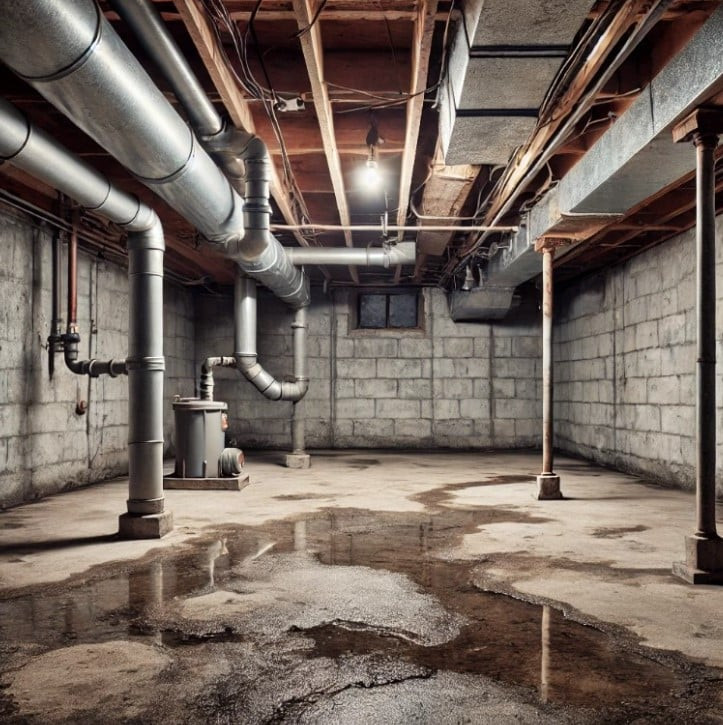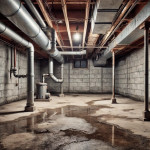Just as you’re considering renovating your basement, perhaps it’s no coincidence that we’re here discussing the importance of basement waterproofing.
You’re probably aware that moisture and leaks can pose a significant threat to your basement’s integrity. But did you know there are three different types of basement waterproofing methods to consider?
Each has its own set of benefits and drawbacks, and the best choice depends on your specific circumstances. Intrigued? Let’s explore this further.
Key Takeaways
- Interior waterproofing methods include sealants, water drainage, sump pumps, and require regular maintenance.
- Exterior waterproofing offers benefits like enhancing structural integrity, preventing mold growth, and increasing property value.
- Drainage-focused methods involve redirecting water from the foundation using systems like sump pumps and dehumidifiers.
- Choose the best waterproofing method based on the extent of water problems, with poured concrete basements benefiting from interior waterproofing and block or stone basements from exterior waterproofing.
Understanding Basement Waterproofing
Before you can effectively waterproof your basement, it’s crucial that you understand the various methods of basement waterproofing and how they protect your home from potential water damage. There are primarily three types: interior, exterior, and drainage-focused methods.
Interior waterproofing, often referred to as water control, doesn’t stop the water from entering your basement. Instead, it manages the water once it’s inside. It’s usually the least expensive method and doesn’t require exterior excavation. However, if not done correctly, it can lead to further damage.
Exterior waterproofing, on the other hand, blocks water from entering your basement in the first place. It’s the most effective method, but also the most expensive. It often involves excavating around your home to install a waterproof coating or membrane on the outside of the basement walls.
Lastly, drainage-focused methods aim to divert water away from your home. This could be through the installation of a sump pump or improving the grading around your property.
Interior Basement Waterproofing Overview
Having explored the broad categories of basement waterproofing, let’s now focus on the specifics of interior waterproofing, a method that manages water infiltration inside your basement. Unlike exterior waterproofing, this method doesn’t prevent water from entering the basement walls. Instead, it deals with the water once it’s inside, directing it to a sump pump system that removes it.
Now let’s breakdown the major components of an interior waterproofing system:
| Component | Purpose | Maintenance |
| Sealants | Applied to walls and floors to repel water | Regular inspections |
| Water Drain | Installed around the perimeter of the basement | Requires occasional cleaning |
| Sump Pump | Extracts accumulated water | Regular testing and cleaning |
Remember, the effectiveness of these components is interconnected. Regular maintenance ensures optimal performance and a dry basement.
Interior waterproofing is typically less expensive and disruptive than exterior methods. However, it’s not a one-size-fits-all solution. It’s vital to understand your basement’s specific needs and issues before deciding on the best waterproofing strategy. Consulting with a professional can offer invaluable insights and guide you to the most suitable solution for your home.
Benefits of Exterior Waterproofing
Now, let’s delve into the numerous benefits of exterior waterproofing, a proactive approach that prevents water from ever making its way into your basement. One of the most significant advantages is the sheer peace of mind that comes with knowing your home is protected from potential water damage. You’re not just fixing a problem; you’re avoiding it altogether.
Let’s break down some of the key benefits:
- Enhanced Protection:
- Structural Integrity: Exterior waterproofing fortifies your home’s foundation against water-related damages, preserving its structural integrity.
- Mold Prevention: By keeping water out, you’ll drastically reduce the risk of mold, which can be hazardous to your health.
- Financial Benefits:
- Cost-Effective: It’s a long-term investment that saves you from future repair costs related to water damage.
- Property Value: A waterproofed home is a valuable asset, making it more appealing to potential buyers.
The Drainage System Approach
Diving into the drainage system approach, it’s crucial to understand that this method involves installing a specialized system to redirect water away from your home’s foundation. This approach typically includes a sump pump, interior drainage pipes, and a dehumidifier. The goal is to control the water that enters your basement and prevent it from causing damage.
| Components | Functions |
| Sump pump | To pump out accumulated water |
| Interior drainage pipes | To collect and direct water to the sump pump |
| Dehumidifier | To maintain an ideal humidity level in the basement |
Choosing the Best Waterproofing Method
Often, choosing the best waterproofing method for your basement involves carefully weighing the pros and cons of each approach based on your home’s specific needs and conditions. It’s crucial to consider the extent of your water problem, the structure of your basement, and your budget.
Here’s a brief guide to help you decide:
- Extent of Water Problem
- Minor: If your basement suffers only from occasional dampness, a sealant might be enough.
- Severe: For basements with more severe water problems, you’ll likely need to consider more extensive methods like an interior water drainage system or exterior waterproofing.
- Basement Structure
- Poured Concrete: Poured concrete basements can usually be effectively waterproofed from the interior.
- Masonry: For block or stone basements, exterior waterproofing might be more effective.
Frequently Asked Questions
How Much Does It Typically Cost to Waterproof a Basement?
Waterproofing your basement’s cost can vary greatly. On average, it’ll cost you between $3,000 to $10,000, depending on the method used and the size of the area.
It’s cheaper to use interior methods, costing about $600 to $3,000. Exterior methods are more expensive, running between $5,000 to $15,000.
But don’t forget, while it might seem expensive now, waterproofing can save you a lot of money in potential damage repairs in the future.
How Long Does the Process of Basement Waterproofing Usually Take?
The duration of your basement waterproofing project largely depends on the severity of the issues and the method used. Generally, it can take anywhere from a few days to a couple of weeks.
Simple sealant applications might be done in a day or two. However, if you’re installing an interior water drainage system, it could take up to a week.
More complex exterior waterproofing could take several weeks. Always remember, quality work is worth the wait.
What Are the Potential Health Risks Associated With a Damp or Wet Basement?
Exposure to a damp or wet basement can pose several health risks. You’re potentially inhaling mold spores, which can lead to respiratory issues, allergic reactions, and asthma attacks. Prolonged exposure may cause chronic sinusitis or lung infections. Musty odors can also trigger migraines.
Besides, dampness encourages growth of bacteria and insects, causing further health issues. Therefore, it’s crucial to address wet basement problems promptly to safeguard your health.
Are There Any Specific Maintenance Practices Required After Waterproofing a Basement?
Yes, after waterproofing your basement, there’s certain maintenance you need to perform.
You’ll want to regularly inspect for signs of cracks or leaks, ensuring the waterproofing remains effective.
It’s also crucial to clean out your gutters and downspouts to prevent water buildup.
Lastly, remember to check your sump pump periodically if you have one installed.
Proper upkeep helps maintain the integrity of your waterproofing system, keeping your basement dry and safe.
Can I Waterproof My Basement Myself or Do I Need to Hire a Professional?
You can certainly attempt to waterproof your basement yourself. However, it’s a complex task requiring expertise and the right tools. If done incorrectly, it could lead to more damage.
It’s generally recommended to hire a professional. They’re trained to handle different situations, have the necessary equipment, and can provide a guarantee for the work. While it may cost more upfront, you’re investing in the long-term protection of your home.
Conclusion
In sum, understanding the three types of basement waterproofing – interior, exterior, and drainage systems – is crucial for your home’s longevity. Each has its benefits, but your choice should depend on your specific needs.
Consult with a professional to make the best decision, ensuring your basement stays dry and your home’s value remains high. Remember, a well-maintained basement isn’t just a safe, usable space; it’s an investment in your home’s future.





